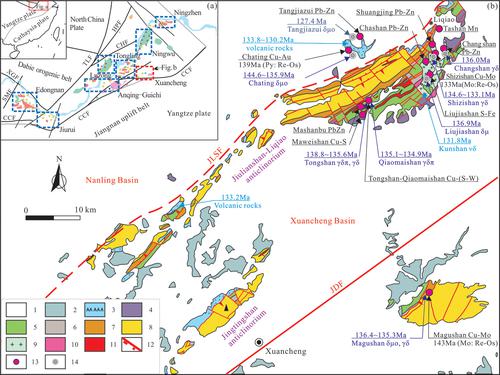当前位置:
X-MOL 学术
›
Acta Geol. Sinica Engl. Ed.
›
论文详情
Our official English website, www.x-mol.net, welcomes your
feedback! (Note: you will need to create a separate account there.)
Genetic Types, Spatiotemporal Distribution of Ore Deposits and Sources of Ore‐forming Materials in the Xuancheng Area, Anhui Province
Acta Geologica Sinica-English Edition ( IF 3.5 ) Pub Date : 2020-12-08 , DOI: 10.1111/1755-6724.14605 Sanming LU 1 , Zanzan ZHANG 1, 2, 3 , Lili ZHAO 1 , Jianshe LI 1 , Zhuang ZHAO 1, 2 , Huasheng QI 1, 2
Acta Geologica Sinica-English Edition ( IF 3.5 ) Pub Date : 2020-12-08 , DOI: 10.1111/1755-6724.14605 Sanming LU 1 , Zanzan ZHANG 1, 2, 3 , Lili ZHAO 1 , Jianshe LI 1 , Zhuang ZHAO 1, 2 , Huasheng QI 1, 2
Affiliation

|
In recent years, several large and medium‐sized ore deposits have been discovered in the shallow cover of Xuancheng, Anhui Province, indicating that this area has a productive metallogenic geological background and may be a potential prospecting region. Based on systematic investigation, the geological and mineralization characteristics of porphyry Cu‐Au deposits and skarn Cu‐Mo‐W deposits in this region have been summarized. Zircon U‐Pb dating (LA‐ICP‐MS) of the Chating quartz‐diorite porphyry and the Kunshan biotite pyroxene diorite yield concordia ages of 145.5 ± 2.1 Ma and 131.8 ± 2.1 Ma, respectively. Meanwhile, the Re‐Os dating analyses for molybdenite from the Shizishan and Magushan skarn Cu‐Mo deposits yielded 133.81 ± 0.86 Ma and 143.8 ± 1.4 Ma ages, respectively. When viewed in conjunction with previous studies, it is suggested that twostage (the early stage of 145–135 Ma and the late stage of 134–125 Ma) magmatism may have occurred during the Mesozoic in Xuancheng region. Early stage intrusive rocks are distributed along both sides of the Jiangnan deep fault (JDF). The intrusive rocks to the north of the JDF are mainly quartz‐diorite porphyry and granodiorite (porphyry) rocks, related to porphyry Cu‐Au deposits and skarn‐type Cu‐Mo‐W deposits. These deposits belong to the first stage of the porphyry‐skarn copper gold metallogenic belt of the Middle‐Lower Yangtze Metallogenic Belt (MLYB), associated with the high potassium calc‐alkaline intermediate‐acid intrusions. The magmatic and ore‐forming materials are mainly derived from the enriched lithospheric mantle. South of the JDF, the Magushan granodiorite is a representative intrusive rock of the first stage I‐type granite, which hosts the Magushan Cu‐Mo skarn deposit, similar to the W‐Mo‐Cu skarn deposits in the Eastern Segment of the Jiangnan Uplift Metallogenic Belt (ESJUB). The magmatic and metallogenic materials mainly came from the Neoproterozoic basement, with the possible participation of a small amount of mantle components. The late stage magmatism was dominated by volcanic rocks with a small amount of intrusive rocks, which were consistent with the limited volcanic‐intrusive activities in the second stage of the MLYB. The H‐O stable isotopes of ore deposits in the region indicate that the ore‐forming hydrothermal fluids of the porphyry and skarn deposits were mostly of magmatic water for the ore‐forming stage, the percentage of meteoric water obviously increasing during the late ore‐forming stage. The ore‐forming materials of the deposits are mainly from the deep magma with a few sedimentary wall rocks, according to the stable carbon isotopes of the carbonates in the ore deposits. Additionally, according to previous research, the molybdenite from the MLYB has a higher Re content than that of the ESJUB. The higher content of Re in the molybdenite from the Shizishan deposit is identical to that of MLYB rather than ESJUB, whereas Re characteristics in molybdenite of Magushan deposit are similar to that of ESJUB. The differences in Re characteristics indicate the different deep processes and ore‐forming material sources (mainly mantle composition for the former and crustal materials for the latter) of these ore deposits on opposite sides of the JDF.
中文翻译:

安徽省宣城市地区矿床成因类型,时空分布及成矿物质来源
近年来,在安徽省宣城县浅层发现了几处大中型矿床,表明该地区具有丰富的成矿地质背景,可能是潜在的勘探区。在系统研究的基础上,总结了该地区斑岩型铜金矿床和矽卡岩型铜钼钨矿床的地质和矿化特征。查通石英闪长斑岩和昆山黑云母辉石闪长闪长闪长岩的锆石U-Pb测年(LA-ICP-MS)的共生年龄分别为145.5±2.1 Ma和131.8±2.1 Ma。同时,对狮子山和玛格森矽卡岩铜钼矿床中辉钼矿的Re-Os定年分析分别得出了133.81±0.86Ma和143.8±1.4Ma的年龄。结合以前的研究来看,建议在宣城地区的中生代发生两期(145-135 Ma的早期阶段和134-125 Ma的晚期阶段)岩浆作用。早期侵入岩分布在江南深断层(JDF)的两侧。JDF北部的侵入岩主要是石英闪长岩斑岩和花岗闪长岩(斑岩),与斑岩型铜金矿床和矽卡岩型铜钼钨矿床有关。这些矿床属于中低扬子成矿带(MLYB)斑岩-矽卡岩型铜金成矿带的第一阶段,与高钾钙碱性中间酸侵入有关。岩浆和成矿物质主要来自丰富的岩石圈地幔。在JDF的南部,玛格山花岗闪长岩是第一阶段I型花岗岩的代表性侵入岩,其拥有玛格山铜钼矽卡岩矿床,类似于江南隆起成矿带东段的钨钼铜矽卡岩矿床。岩浆和成矿物质主要来自新元古代基底,可能有少量地幔成分参与。晚期岩浆活动以火山岩为主,少量侵入岩,这与MLYB第二阶段有限的火山侵入活动相一致。该区域矿床的H-O稳定同位素表明,在成矿阶段,斑岩和矽卡岩矿床的成矿热液主要为岩浆水,在成矿后期,流水的百分比明显增加。根据矿床碳酸盐的稳定碳同位素,矿床的成矿物质主要来自深部岩浆和少量沉积围岩。此外,根据先前的研究,MLYB中的辉钼矿比ESJUB中的辉石具有更高的Re含量。石子山矿床辉钼矿中较高的含量与MLYB相同,而非ESJUB,而玛格山矿床辉钼矿中的Re特征与ESJUB相似。Re特征的差异表明,这些在JDF两侧的矿床的深部过程和成矿物质来源(主要是前者的地幔成分和后者的地壳成分)不同。
更新日期:2020-12-29
中文翻译:

安徽省宣城市地区矿床成因类型,时空分布及成矿物质来源
近年来,在安徽省宣城县浅层发现了几处大中型矿床,表明该地区具有丰富的成矿地质背景,可能是潜在的勘探区。在系统研究的基础上,总结了该地区斑岩型铜金矿床和矽卡岩型铜钼钨矿床的地质和矿化特征。查通石英闪长斑岩和昆山黑云母辉石闪长闪长闪长岩的锆石U-Pb测年(LA-ICP-MS)的共生年龄分别为145.5±2.1 Ma和131.8±2.1 Ma。同时,对狮子山和玛格森矽卡岩铜钼矿床中辉钼矿的Re-Os定年分析分别得出了133.81±0.86Ma和143.8±1.4Ma的年龄。结合以前的研究来看,建议在宣城地区的中生代发生两期(145-135 Ma的早期阶段和134-125 Ma的晚期阶段)岩浆作用。早期侵入岩分布在江南深断层(JDF)的两侧。JDF北部的侵入岩主要是石英闪长岩斑岩和花岗闪长岩(斑岩),与斑岩型铜金矿床和矽卡岩型铜钼钨矿床有关。这些矿床属于中低扬子成矿带(MLYB)斑岩-矽卡岩型铜金成矿带的第一阶段,与高钾钙碱性中间酸侵入有关。岩浆和成矿物质主要来自丰富的岩石圈地幔。在JDF的南部,玛格山花岗闪长岩是第一阶段I型花岗岩的代表性侵入岩,其拥有玛格山铜钼矽卡岩矿床,类似于江南隆起成矿带东段的钨钼铜矽卡岩矿床。岩浆和成矿物质主要来自新元古代基底,可能有少量地幔成分参与。晚期岩浆活动以火山岩为主,少量侵入岩,这与MLYB第二阶段有限的火山侵入活动相一致。该区域矿床的H-O稳定同位素表明,在成矿阶段,斑岩和矽卡岩矿床的成矿热液主要为岩浆水,在成矿后期,流水的百分比明显增加。根据矿床碳酸盐的稳定碳同位素,矿床的成矿物质主要来自深部岩浆和少量沉积围岩。此外,根据先前的研究,MLYB中的辉钼矿比ESJUB中的辉石具有更高的Re含量。石子山矿床辉钼矿中较高的含量与MLYB相同,而非ESJUB,而玛格山矿床辉钼矿中的Re特征与ESJUB相似。Re特征的差异表明,这些在JDF两侧的矿床的深部过程和成矿物质来源(主要是前者的地幔成分和后者的地壳成分)不同。











































 京公网安备 11010802027423号
京公网安备 11010802027423号